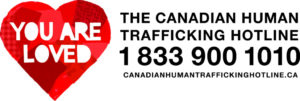Human Trafficking
Young people experiencing homelessness are one of the most vulnerable groups when it comes to human trafficking. Young people and other housing-insecure individuals may be lured or groomed by traffickers who befriend them, give them shelter and take care of their basic needs. This collection provides practical resources to help service providers and others recognize the signs of human trafficking, intervene safely and make referrals to appropriate supports.
What is this collection all about?
- Know the facts about human trafficking in Canada and in particular, the sexual exploitation of young women.
- Learn how to recognize signs of grooming and recruitment.
- Gain skills for first responders to intervene safely to prevent further harm.
- Read first-hand experiences from survivors.
- Explore practical ways to provide support for survivors
Canadian Human Trafficking Hotline. The Canadian Human Trafficking Hotline is a confidential service available in multiple languages. Support can be accessed 24/7 to connect victims and survivors with social services, law enforcement, and emergency services, as well as receive tips from the public.

